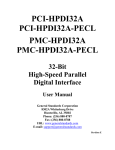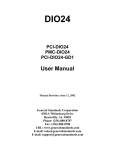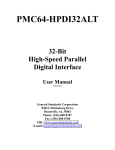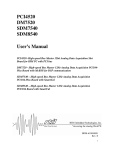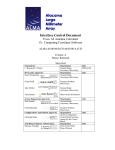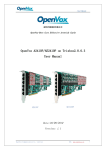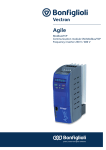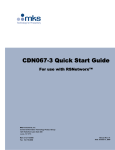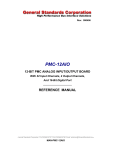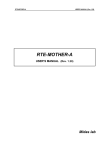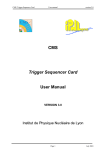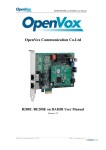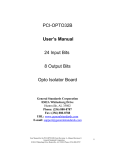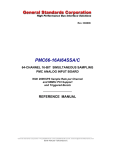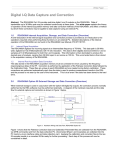Download User Manual - General Standards Corporation
Transcript
PCI-DMI32 User Manual Preliminary General Standards Corporation 8302A Whitesburg Drive Huntsville, AL 35802 Phone: (256) 880-8787 Fax: (256) 880-8788 URL: www.generalstandards.com E-mail: [email protected] PREFACE General Standards Corporation Preliminary, Revised: December 1997 Copyright (C) 1999 General Standards Corp. Additional copies of this manual or other literature may be obtained from: General Standards Corporation 8302A Whitesburg Dr. Huntsville, Alabama 35802 Tele: (256) 880-8787 FAX: (256) 880-8788 E-mail: [email protected] The information in this document is subject to change without notice. General Standards Corp. makes no warranty of any kind with regard to this material, including, but not limited to, the implied warranties of merchantability and fitness for a particular purpose. Although extensive editing and reviews are performed before release to ECO control, General Standards Corp. assumes no responsibility for any errors that may exist in this document. No commitment is made to update or keep current the information contained in this document. General Standards Corp. does not assume any liability arising out of the application or use of any product or circuit described herein, nor is any license conveyed under any patent rights or any rights of others. General Standards Corp. assumes no responsibility for any consequences resulting from omissions or errors in this manual, or from the use of information contained herein. General Standards Corp. reserves the right to make any changes, without notice, to this product to improve reliability, performance, function, or design. All rights reserved No part of this document may be copied or reproduced in any form or by any means without prior written consent of General Standards Corp. This user’s manual provides information on the specifications, theory of operation, register level programming, installation of the board and information required for customized hardware/software development. User Manual for the PCI-DMI32, Manual Revision: A General Standards Corporation 8302A Whitesburg Drive Huntsville, AL 35802, Phone: (256) 880-8787 II RELATED PUBLICATIONS The following manuals and specifications provide the necessary information for in depth understanding of the specialized parts used on this board. EIA Standard for the RS-422A Interface (EIA order number EIA-RS-422A) PCI Local Bus Specification Revision 2.1 June 1, 1995. Questions regarding the PCI specification be forwarded to: PCI Special Interest Group P.O. Box 14070 Portland, OR 97214 (800) 433- 5177 (U.S.) (503) 797-4207 (International) (503) 234-6762 (FAX) User Manual for the PCI-DMI32, Manual Revision: A General Standards Corporation 8302A Whitesburg Drive Huntsville, AL 35802, Phone: (256) 880-8787 III PCI-DMI32 DOCUMENTATION HISTORY 1) 03/20/2000: Converted PCI-HPDI32A Manual to PCI-HPDI32A-PRINT 2) 05/23/2001: Document Updates User Manual for the PCI-DMI32, Manual Revision: A General Standards Corporation 8302A Whitesburg Drive Huntsville, AL 35802, Phone: (256) 880-8787 IV TABLE of CONTENTS CHAPTER 1: INTRODUCTION.................................................................................................................................................5 1.0 1.2 FUNCTIONAL DESCRIPTION................................................................................................................................. 5 FIFOS ............................................................................................................................................................................ 7 CHAPTER 2: REGISTERS ..........................................................................................................................................................8 2.0 2.1 PCI-HPDI32-2GB-LVDS-A REGISTER INFORMATION...................... ERROR! B OOKMARK NOT DEFINED. PCI CONFIGURATION REGISTERS ....................................................... ERROR! B OOKMARK NOT DEFINED . Table 2.1-1: 2.2 Register Mapping.....................................................................................Error! Bookmark not defined. PLX REGISTERS......................................................................................... ERROR! B OOKMARK NOT DEFINED . Table 2.2-1: Table 2.2-2: Table 2.2-3: Table 2.2-3: LOCAL CONFIGURATION REGISTERS...............................................Error! Bookmark not defined. RUN TIME REGISTERS............................................................................Error! Bookmark not defined. DMA REGISTERS......................................................................................Error! Bookmark not defined. MESSAGING QUEUE REGISTERS.........................................................Error! Bookmark not defined. 2.3 PCI CONFIGURATION REGISTER BIT MAPS..................................... ERROR! B OOKMARK NOT DEFINED . 2.3.1 PCI Configuration ID Register (Offset 0x00).................................................. Error! Bookmark not defined. 2.3.2 PCI Command Register (Offset 0x04) .............................................................. Error! Bookmark not defined. 2.3.3 PCI Status Register (Offset 0x06)..................................................................... Error! Bookmark not defined. 2.3.4 PCI Revision ID Register (Offset 0x08)........................................................... Error! Bookmark not defined. 2.3.5 PCI Class Code Register (Offset 0x09..0B) ..................................................... Error! Bookmark not defined. 2.3.6 PCI Cache Line Size Register (Offset 0x0C).................................................... Error! Bookmark not defined. 2.3.7 PCI Latency Timer Register (Offset 0x0D)...................................................... Error! Bookmark not defined. 2.3.8 PCI Header Type Register (Offset 0x0E)......................................................... Error! Bookmark not defined. 2.3.9 PCI Built-In Self Test (BIST) Register (PCI Offset 0x0F).............................. Error! Bookmark not defined. 2.3.10 PCI Base Address Register for Memory Access to Runtime Registers (Offset 0x010)..................Error! Bookmark not defined. 2.3.11 PCI Base Address Register for I/O Access to Runtime Registers (Offset 0x14)..Error! Bookmark not defined. 2.3.12 PCI Base Address Register for Memory Access to Local Address Space 0 (Offset 0x18) ...........Error! Bookmark not defined. 2.3.13 PCI Base Address Register for Memory Access to Local Address Space 1 (Offset 0x1C)...........Error! Bookmark not defined. 2.3.14 PCI Base Address Register (Offset 0x20)................................................. Error! Bookmark not defined. 2.3.15 PCI Base Address Register (Offset 0x24)................................................. Error! Bookmark not defined. 2.3.16 PCI Cardbus CIS Pointer Register (Offset 0x28)....................................... Error! Bookmark not defined. 2.3.17 PCI Subsystem Vendor ID Register (Offset 0x2C) ................................... Error! Bookmark not defined. 2.3.18 PCI Subsystem ID Register (Offset 0x2E).................................................. Error! Bookmark not defined. 2.3.19 PCI Expansion ROM Base Register (Offset 0x30) .................................... Error! Bookmark not defined. 2.3.20 PCI Interrupt Line Register (Offset 0x3C).................................................. Error! Bookmark not defined. 2.3.21 PCI Interrupt Pin Register (Offset 0x3D).................................................... Error! Bookmark not defined. 2.3.22 PCI Min_Gnt Register (Offset 0x3E)........................................................... Error! Bookmark not defined. 2.3.23 PCI Max_Lat Register (Offset 0x3F)........................................................... Error! Bookmark not defined. 2.4 LOCAL CONFIGURATION REGISTERS................................................ ERROR! B OOKMARK NOT DEFINED . 2.4.1 Local Address Space 0 Range Register for PCI to Local bus (PCI 0x00) (LOC 0x80)Error! Bookmark not defined. 2.4.2 Local Address Space 0 Local Base Address (Re-map) Register for PCI to Local Bus (PCI 0x04) (LOC 0x84) Error! Bookmark not defined. 2.4.3 Mode/Arbitration Register (PCI 0x08) (LOC 0x88)........................................ Error! Bookmark not defined. 2.4.4 Big/Little Endian Descriptor Register (PCI 0x0C) (LOC 0x8C)..................... Error! Bookmark not defined. User Manual for the PCI-DMI32, Manual Revision: A General Standards Corporation 8302A Whitesburg Drive Huntsville, AL 35802, Phone: (256) 880-8787 1 2.4.5 Local Expansion ROM Range Register for PCI to Local Bus (PCI 0x10) (LOC 0x90) Error! Bookmark not defined. 2.4.6 Local Expansion ROM Local Base Address (Re-map) register for PCI to Local Bus and BREQo Control (PCI 0x14) (LOC 0x94)....................................................................................................... Error! Bookmark not defined. 2.4.7 Local Address Space 0/Expansion ROM Bus Region Descriptor Register (PCI 0x18) (LOC 0x98) ...Error! Bookmark not defined. 2.4.8 Local Range register for Direct Master to PCI (PCI 0x1C) (LOC 0x9C) ...... Error! Bookmark not defined. 2.4.9 Local Bus Base Address register for Direct Master to PCI Memory (PCI 0x20) (LOC 0xA0).............Error! Bookmark not defined. 2.4.10 Local Base Address for Direct Master to PCI IO/CFG Register (PCI 0x24) (LOC 0xA4)................Error! Bookmark not defined. 2.4.11 PCI Base Address (Re-map) register for Direct Master to PCI Memory (PCI 0x28) (LOC 0xA8)..Error! Bookmark not defined. 2.4.12 PCI Configuration Address Register for Direct Master to PCI IO/CFG (PCI 0x2C) (LOC 0xAC)..Error! Bookmark not defined. 2.4.13 Local Address Space 1 Range Register for PCI to Local Bus (PCI 0xF0) (LOC 0x170)...................Error! Bookmark not defined. 2.4.14 Local Address Space 1 Local Base Address (Remap) Register (PCI 0xF4) (LOC 0x174) ...............Error! Bookmark not defined. 2.4.15 Local Address Space 1 Bus Region Descriptor Register (PCI 0xF8) (LOC 0x178)Error! Bookmark not defined. 2.5 RUNTIME REGISTERS.............................................................................. ERROR! B OOKMARK NOT DEFINED . 2.5.1 Mailbox Register 0 (PCI 0x40) (LOC 0xC0)...................................................... Error! Bookmark not defined. 2.5.2 Mailbox Register 1 (PCI 0x44) (LOC 0xC4)...................................................... Error! Bookmark not defined. 2.5.3 Mailbox Register 2 (PCI 0x48) (LOC 0xC8)...................................................... Error! Bookmark not defined. 2.5.4 Mailbox Register 3 (PCI 0x4C) (LOC 0xCC) .................................................... Error! Bookmark not defined. 2.5.5 Mailbox Register 4 (PCI 0x50) (LOC 0xD0) ..................................................... Error! Bookmark not defined. 2.5.6 Mailbox Register 5 (PCI 0x54) (LOC 0xD4) ..................................................... Error! Bookmark not defined. 2.5.7 Mailbox Register 6 (PCI 0x58) (LOC 0xD8) ..................................................... Error! Bookmark not defined. 2.5.8 Mailbox Register 7 (PCI 0x5C) (LOC 0xDC).................................................... Error! Bookmark not defined. 2.5.9 PCI to Local Doorbell Register Description (PCI 0x60) (LOC 0xE0)............ Error! Bookmark not defined. 2.5.10 Local to PCI Doorbell Register Description (PCI 0x64) (LOC 0xE4)....... Error! Bookmark not defined. 2.5.11 Interrupt Control /Status (PCI 0x68) (LOC 0xE8) ...................................... Error! Bookmark not defined. 2.5.12 Serial EEPROM Control, PCI Command Codes, User I/O Control, Init Control Register (PCI 0x6C) (LOC 0xEC)......................................................................................................................... Error! Bookmark not defined. 2.5.13 PCI Permanent Configuration ID Register (PCI 0x70) (LOC 0xF0) ........ Error! Bookmark not defined. 2.5.14 PCI Permanent Revision ID Register (PCI 0x74) (LOC 0xF4) ................. Error! Bookmark not defined. 2.6 LOCAL DMA REGISTERS........................................................................ ERROR! B OOKMARK NOT DEFINED . 2.6.1 DMA Channel 0 Mode Register (LOC 0x100)................................................ Error! Bookmark not defined. 2.6.2 DMA Channel 0 PCI Address Register (LOC 0x104).................................... Error! Bookmark not defined. 2.6.3 DMA Channel 0 Local Address Register (LOC 0x108) ................................ Error! Bookmark not defined. 2.6.4 DMA Channel 0 Transfer Size (Bytes) Register (LOC 0x10C)..................... Error! Bookmark not defined. 2.6.5 DMA Channel 0 Descriptor Pointer Register (LOC 0x110).......................... Error! Bookmark not defined. 2.6.6 DMA Channel 1 Mode Register (LOC 0x114)................................................ Error! Bookmark not defined. 2.6.7 DMA Channel 1 PCI Data Address Register (LOC 0x118) .......................... Error! Bookmark not defined. 2.6.8 DMA Channel 1 Local Data Address Register (LOC 0x11C) ...................... Error! Bookmark not defined. 2.6.9 DMA Channel 1 Transfer Size (bytes) register (LOC 0x120)....................... Error! Bookmark not defined. 2.6.10 DMA Channel 1 Descriptor Pointer Register (LOC 0x124)..................... Error! Bookmark not defined. 2.6.11 DMA Command/Status Register (LOC 0x128).......................................... Error! Bookmark not defined. 2.6.12 DMA Channel 1 Command/Status Register 0 (LOC 0x128).................... Error! Bookmark not defined. 2.6.13 DMA Arbitration Register 1 (LOC 0x12C) same as Mode /Arbitration Register at address (LOC 0x88) Error! Bookmark not defined. 2.7 MESSAGING QUEUE REGISTERS.......................................................... ERROR! B OOKMARK NOT DEFINED . 2.7.1 Outbound Post List FIFO Interrupt Status Register (PCI 0x30) (LOC 0xB0)Error! Bookmark not defined. User Manual for the PCI-DMI32, Manual Revision: A General Standards Corporation 8302A Whitesburg Drive Huntsville, AL 35802, Phone: (256) 880-8787 2 2.7.2 2.7.3 2.7.4 2.7.5 2.7.6 2.7.7 2.7.8 2.7.9 2.7.10 2.7.11 2.7.12 2.7.13 2.7.14 2.7.15 Outbound Post List FIFO Interrupt Status Register (PCI 0x34) (LOC 0xB4)Error! Bookmark not defined. Inbound Queue Port Register (PCI 0x40)........................................................ Error! Bookmark not defined. Outbound Queue Port Register (PCI 0x44)..................................................... Error! Bookmark not defined. Messaging Queue Configuration Register (PCI 0xC0) (LOC 0x140)........... Error! Bookmark not defined. Queue Base Address Register (PCI 0xC4) (LOC 0x144) ............................... Error! Bookmark not defined. Inbound Free Head Pointer Register (PCI 0xC8) (LOC 0x148)..................... Error! Bookmark not defined. Inbound Free Head Tail Register (PCI 0xCC) (LOC 0x14C).......................... Error! Bookmark not defined. Inbound Post Head Pointer Register (PCI 0xD0) (LOC 0x150) .................... Error! Bookmark not defined. Inbound Post Tail Pointer Register (PCI 0xD4) (LOC 0x154).................. Error! Bookmark not defined. Outbound Free Head Pointer Register (PCI 0xD8) (LOC 0x158)............. Error! Bookmark not defined. Outbound Free Tail Pointer Register (PCI 0xDC) (LOC 0x15C).............. Error! Bookmark not defined. Outbound Post Head Pointer Register (PCI 0xE0) (LOC 0x160)............. Error! Bookmark not defined. Outbound Post Tail Pointer Register (PCI 0xE4) (LOC 0x164)................ Error! Bookmark not defined. Queue Status/Control Register (PCI 0xE8) (LOC 0x168).......................... Error! Bookmark not defined. 2.8 PCI CONFIGURATION REGISTER BIT DESCRIPTIONS.................... ERROR! B OOKMARK NOT DEFINED . 2.8.1 PCI Configuration ID Register (Offset 0x00).................................................. Error! Bookmark not defined. 2.8.2 PCI Command Register (Offset 0x04) .............................................................. Error! Bookmark not defined. 2.8.3 PCI Status Register (Offset 0x06)..................................................................... Error! Bookmark not defined. 2.8.4 PCI Revision ID Register (Offset 0x08)........................................................... Error! Bookmark not defined. 2.8.5 PCI Class Code Register (Offset 0x09 - 0B).................................................... Error! Bookmark not defined. 2.8.6 PCI Cache Line Size Register (Offset 0x0C).................................................... Error! Bookmark not defined. 2.8.7 PCI Latency Timer Register (Offset 0x0D)...................................................... Error! Bookmark not defined. 2.8.8 PCI Header Type Register (Offset 0x0E)......................................................... Error! Bookmark not defined. 2.8.9 PCI Built-In Self Test (BIST) Register (PCI Offset 0x0F).............................. Error! Bookmark not defined. 2.8.10 PCI Base Address Register for Memory Access to Runtime Registers (Offset 0x010)..................Error! Bookmark not defined. 2.8.11 PCI Base Address Register for I/O Access to Runtime Registers (Offset 0x14)..Error! Bookmark not defined. 2.8.12 PCI Base Address Register for Memory Access to Local Address Space 0 (Offset 0x18) ...........Error! Bookmark not defined. 2.8.13 PCI Base Address Register for Memory Accesses to Local Address Space 1 (Offset 0x1C).......Error! Bookmark not defined. 2.8.14 PCI Base Address Register (Offset 0x20)................................................. Error! Bookmark not defined. 2.8.15 PCI Base Address Register (Offset 0x24)................................................. Error! Bookmark not defined. 2.8.16 PCI Base Cardbus CIS Pointer Register (Offset 0x28) ............................. Error! Bookmark not defined. 2.8.17 PCI Subsystem Vendor ID Register (Offset 0x2C) ................................... Error! Bookmark not defined. 2.8.18 PCI Subsystem ID Register (Offset 0x2E).................................................. Error! Bookmark not defined. 2.8.19 PCI Expansion ROM Base Register (Offset 0x30) .................................... Error! Bookmark not defined. 2.8.20 PCI Interrupt Line Register (Offset 0x3C).................................................. Error! Bookmark not defined. 2.8.21 PCI Interrupt Pin Register (Offset 0x3D).................................................... Error! Bookmark not defined. 2.8.22 PCI Min_Gnt Register (Offset 0x3E)........................................................... Error! Bookmark not defined. 2.8.23 PCI Max_Lat Register (Offset 0x3F)........................................................... Error! Bookmark not defined. 2.9 LOCAL CONFIGURATION REGISTERS BIT DESCRIPTIONS.................... ERROR! B OOKMARK NOT DEFINED . 2.9.1 Local Address Space 0 Range Register for PCI to Local bus (PCI 0x00) (LOC 0x80)Error! Bookmark not defined. 2.9.2 Local Address Space 0 Local Base Address (Re-map) Register for PCI to Local Bus (PCI 0x04) (LOC 0x84) Error! Bookmark not defined. 2.9.3 Mode/Arbitration Register (PCI 0x08) (LOC 0x88)........................................ Error! Bookmark not defined. 2.9.4 Local Register (PCI 0x0C) (LOC 0x8C)............................................................. Error! Bookmark not defined. 2.9.5 Local Expansion ROM Range Register for PCI to Local Bus (PCI 0x10) (LOC 0x90)Error! Bookmark not defined. 2.9.6 Local Expansion ROM Local Base Address (Re-map) register for PCI to Local Bus and BREQo Control (PCI 0x14) (LOC 0x94)....................................................................................................... Error! Bookmark not defined. User Manual for the PCI-DMI32, Manual Revision: A General Standards Corporation 8302A Whitesburg Drive Huntsville, AL 35802, Phone: (256) 880-8787 3 2.9.7 Local Bus Region Descriptor for PCI to Local Accesses Register (PCI 0x18) (LOC 0x98)..................Error! Bookmark not defined. 2.9.8 Local Range register for Direct Master to PCI (PCI 0x1C) (LOC 0x9C) ...... Error! Bookmark not defined. 2.9.9 Local Bus Base Address register for Direct Master to PCI Memory (PCI 0x20) (LOC 0xA0).............Error! Bookmark not defined. 2.9.10 Local Base Address for Direct Master to PCI IO/CFG Register (PCI 0x24) (LOC 0xA4)................Error! Bookmark not defined. 2.9.11 PCI Base Address (Re-map) register for Direct Master to PCI (PCI 0x28) (LOC 0xA8)..................Error! Bookmark not defined. 2.9.12 PCI Configuration Address Register for Direct Master to PCI IO/CFG (PCI 0x2C) (LOC 0xAC)..Error! Bookmark not defined. 2.9.13 Local Address Space 1 Range Register for PCI to Local Bus (PCI 0xF0) (LOC 0x170)...................Error! Bookmark not defined. 2.9.14 Local Address Space 1 Local Base Address (Remap) Register (PCI 0xF4) (LOC 0x174) ...............Error! Bookmark not defined. 2.9.15 Local Address Space 1 Bus Region Descriptor Register (PCI 0xF8) (LOC 0x178)Error! Bookmark not defined. 2.10 SHARED RUNTIME REGISTERS BIT DESCRIPTIONS.............................. ERROR! B OOKMARK NOT DEFINED . 2.10.1 Mailbox Register 0 (PCI 0x40) (LOC 0xC0)................................................. Error! Bookmark not defined. 2.10.2 Mailbox Register 1 (PCI 0x44) (LOC 0xC4)................................................. Error! Bookmark not defined. 2.10.2 Mailbox Register 2 (PCI 0x48) (LOC 0xC8)................................................. Error! Bookmark not defined. 2.10.3 Mailbox Register 3 (PCI 0x4C) (LOC 0xCC) ............................................... Error! Bookmark not defined. 2.10.4 Mailbox Register 4 (PCI 0x50) (LOC 0xD0) ................................................ Error! Bookmark not defined. 2.10.5 Mailbox Register 5 (PCI 0x54) (LOC 0xD4) ................................................ Error! Bookmark not defined. 2.10.6 Mailbox Register 6 (PCI 0x58) (LOC 0xD8) ................................................ Error! Bookmark not defined. 2.10.7 Mailbox Register 7 (PCI 0x5C) (LOC 0xDC)............................................... Error! Bookmark not defined. 2.10.8 PCI to Local Doorbell Register Description (PCI 0x60) (LOC 0xE0)....... Error! Bookmark not defined. 2.10.9 Local to PCI Doorbell Register Description (PCI 0x64) (LOC 0xE4)....... Error! Bookmark not defined. 2.10.10 Interrupt Control /Status (PCI 0x68) (LOC 0xE8) ...................................... Error! Bookmark not defined. 2.10.11 EEPROM Control, PCI Command Codes, User I/O Control, Init Control Register (LOC 0xEC) ....Error! Bookmark not defined. 2.10.12 PCI Permanent Configuration ID Register (PCI 0x70) (LOC 0xF0) ......... Error! Bookmark not defined. 2.10.13 PCI Permanent Revision ID Register (PCI 0x74) (LOC 0xF4) .................. Error! Bookmark not defined. 2.11 LOCAL DMA REGISTERS........................................................................ ERROR! B OOKMARK NOT DEFINED . 2.11.1 DMA Channel 0 Mode Register (LOC 0x100)........................................... Error! Bookmark not defined. 2.11.2 DMA Channel 0 PCI Address Register (LOC 0x104)............................... Error! Bookmark not defined. 2.11.3 DMA Channel 0 Local Address Register (LOC 0x108) ........................... Error! Bookmark not defined. 2.11.4 DMA Channel 0 Transfer Size (Bytes) Register (LOC 0x10C)................ Error! Bookmark not defined. 2.11.5 DMA Channel 0 Descriptor Pointer Register (LOC 0x110)..................... Error! Bookmark not defined. 2.11.6 DMA Channel 1 Mode Register (LOC 0x114)........................................... Error! Bookmark not defined. 2.11.7 DMA Channel 1 PCI Data Address Register (LOC 0x118) ..................... Error! Bookmark not defined. 2.11.8 DMA Channel 1 Local Data Address Register (LOC 0x11C) ................. Error! Bookmark not defined. 2.11.9 DMA Channel 1 Transfer Size (bytes) register (LOC 0x120).................. Error! Bookmark not defined. 2.11.10 DMA Channel 1 Descriptor Pointer Register (LOC 0x124)..................... Error! Bookmark not defined. 2.11.11 DMA Command/Status Register (LOC 0x128).......................................... Error! Bookmark not defined. 2.11.12 DMA Command/Status Register (LOC 0x129).......................................... Error! Bookmark not defined. 2.11.13 DMA Arbitration Register 0 (LOC 0x12C). Same as Mode/Arbitration Register at address ........Error! Bookmark not defined. 2.11.14 DMA Threshold Register 1 (LOC 0x130)................................................... Error! Bookmark not defined. 2.12 MESSAGING QUEUE REGISTERS.......................................................... ERROR! B OOKMARK NOT DEFINED . 2.12.1 Outbound Post List FIFO Interrupt Status Register (PCI 0x30) (LOC 0xB0).........Error! Bookmark not defined. 2.12.2 Outbound Post List FIFO Interrupt Status Register (PCI 0x34) (LOC 0xB4).........Error! Bookmark not defined. User Manual for the PCI-DMI32, Manual Revision: A General Standards Corporation 8302A Whitesburg Drive Huntsville, AL 35802, Phone: (256) 880-8787 4 2.12.3 Inbound Queue Port Register (PCI 0x40)................................................... Error! Bookmark not defined. 2.12.4 Outbound Queue Port Register (PCI 0x44)................................................ Error! Bookmark not defined. 2.12.5 Messaging Queue Configuration Register (PCI 0xC0) (LOC 0x140)...... Error! Bookmark not defined. 2.12.6 Queue Base Address Register (PCI 0xC4) (LOC 0x144) .......................... Error! Bookmark not defined. 2.12.7 Inbound Free Head Pointer Register (PCI 0xC8) (LOC 0x148)................ Error! Bookmark not defined. 2.12.8 Inbound Free Head Tail Register (PCI 0xCC) (LOC 0x14C)..................... Error! Bookmark not defined. 2.12.9 Inbound Post Head Pointer Register (PCI 0xD0) (LOC 0x150) ............... Error! Bookmark not defined. 2.12.10 Inbound Post Tail Pointer Register (PCI 0xD4) (LOC 0x154).................. Error! Bookmark not defined. 2.12.11 Outbound Free Head Pointer Register (PCI 0xD8) (LOC 0x158)............. Error! Bookmark not defined. 2.12.12 Outbound Free Tail Pointer Register (PCI 0xDC) (LOC 0x15C).............. Error! Bookmark not defined. 2.12.13 Outbound Post Head Pointer Register (PCI 0xE0) (LOC 0x160)............. Error! Bookmark not defined. 2.12.14 Outbound Post Tail Pointer Register (PCI 0xE4) (LOC 0x164)................ Error! Bookmark not defined. 2.12.15 Queue Status/Control Register (PCI 0xE8) (LOC 0x168).......................... Error! Bookmark not defined. 2.13 PCI-HPDI32-2GB-LVDS-ALOCAL REGISTERS................................................................................................... 12 2.14 PCI-HPDI32-2GB-LVDS-ALOCAL REGISTERS, BIT MAP & BIT DESCRIPTIONS ..................................... 12 2.14.1 FIRMWARE REVISION: (Offset 0x00) ....................................................................................................... 12 2.14.2 BOARD CONTROL: (Offset 0x04)............................................................................................................... 12 2.14.3 BOARD STATUS: (Offset 0x08).................................................................................................................. 14 2.14.4 TX ALMOST: (Offset 0x0C)......................................................................................................................... 15 2.14.6 TX FIFOs: (Offset 0x18) ................................................................................................................................ 15 2.14.12 INTERRUPT CONTROL: (Offset 0x30)...................................................................................................... 15 2.14.13 INTERRUPT STATUS: (Offset 0x34).......................................................................................................... 16 CHAPTER 3: PROGRAMMING..............................................................................................................................................17 3.0 3.1 3.2 3.3 INITIALIZATION ...................................................................................... ERROR! B OOKMARK NOT DEFINED . RESETS ........................................................................................................ ERROR! B OOKMARK NOT DEFINED . FIFOS ............................................................................................................ ERROR! B OOKMARK NOT DEFINED . INTERRUPTS.............................................................................................. ERROR! B OOKMARK NOT DEFINED. CHAPTER 4: HARDWARE CONFIGURATION..................................................................................................................32 4.0 THE ON-BOARD TRANSMIT CLOCK ................................................................................................................ 32 Figure 4.0-1: Oscillator specification........................................................................................................................... 32 4.1 4.2 EEPROM JUMPER (J1)............................................................................................................................................ 32 CABLE CONNECTOR.............................................................................................................................................. 32 Table 4.2-1: Cable Pin-Out: Cable Pin-Out Continued: ..........................................................................................33 CHAPTER 1: INTRODUCTION 2.4.2 FUNCTIONAL DESCRIPTION The PCI-DMI32 Board provides a large on-board memory storage and high-speed, 32-bit parallel interface. It is capable of transmitting or receiving data transfers of up to 200 Mbytes per second on the cable. The PCI-DMI32 Board includes up to 2GB of DRAM, a cable input/output controller, cable transceivers (differential, LVDS), and a DMA controller. The onboard memory can be configured to be accessed either from the PCI bus, or dedicated to the cable transfer. The on-board DRAM does not provide real-time access to the data from the PCI while a transfer is in progress. The DRAM should be initialized via the PCI bus prior to the cable data transfer. When the transfer is enabled, User Manual for the PCI-DMI32, Manual Revision: A General Standards Corporation 8302A Whitesburg Drive Huntsville, AL 35802, Phone: (256) 880-8787 5 the cable data will be either continuously transmitted from the on-board DRAM, or continuously received into the DRAM. Once the transfer is complete, the DRAM may be again accessed from the PCI bus. The transfer controller is designed to allow several different transfer modes. In single transfer mode, a single buffer of data is transferred across the cable and then DRAM control is returned to the PCI bus. The single buffer may start at any address offset within the full 2GB DRAM space, and the transfer buffer size is also defined. In multibuffer mode, multiple buffers may be transferred across the cable. In this manner, the user can define multiple buffers in the DRAM, which will then be transferred continuously to the cable when the transfer is enabled. On-board interrupts are defined to allow the user to update the start buffer address and buffer transfer size as soon as the transfer of one buffer begins. In this manner, the user can dynamically receive or transmit multiple buffers to/from the DRAM in one continuous transfer. Likewise, a single buffer can be transmitted continuously to the cable simply by not updating the start buffer address and buffer transfer size. This allows a continuous buffer of up to 2GB to be transmitted indefinitely on the cable. Note: The PCI-DMI32 is a long card and electrically compliant with PCI 2.1. Due to the height of the DRAM modules, the card requires three PCI slots. User Manual for the PCI-DMI32, Manual Revision: A General Standards Corporation 8302A Whitesburg Drive Huntsville, AL 35802, Phone: (256) 880-8787 6 LVDS User I/O 2GB DRAM text text text Addr P C I Addr Addr Ctrl Data Control FPGA Ctrl Transmit FIFO PLX 9080 B u s T a r g e t Data Receive FIFO Data LVDS I n t e r f a c e Data Figure 1.0-2: Functional Block Diagram 2.4.3 1.1 CABLE INTERFACE The cable interface consists of 32 bits of data, two clocks, and 14 user definable bi-directional signals. All of which employ differential LVDS. Refer to cable pin-out Table 4.2-1. 2.4.4 1.2 DIMMS The PCI-DIM32 board may be populated with up to four DIMMs for a total of 2 GB of memory. Currently, the PCI-DMI32 supports 512MB SDRAM modules for a total of 512MB, 1GB, 1.5GB or 2GB of memory storage. General Standards Corporation is looking into the possibility to migrate up/down using different density DIMMs. Please contact the factory for more information and availability. User Manual for the PCI-DMI32, Manual Revision: A General Standards Corporation 8302A Whitesburg Drive Huntsville, AL 35802, Phone: (256) 880-8787 7 CHAPTER 2: PROGRAMMING 2.4.5 2.0 INITIALIZATION Several functions on the PCI-DMI32 board will generally be unchanged in a given application. These include interrupt setup and Users I/O direction setup. Therefore, initializing these functions board will generally need to be done only once by the software. However, if a Board Reset is performed, all registers will return to their default values. Software must reinitialize the board following a Board Reset. After a board reset is performed, the following will be true: a. all cable transceivers will be turned off; b. all interrupts will be disabled; c. the SDRAM modules will be empty; d. all RW registers will be set to 0 (Board Control Register bits are set to 0 on system reset) 2.4.6 RESETS The Board Control Register contains a bit which are used to reset the local logic functions. This bit performs a reset when the software writes a ‘1’. The reset bit is also self-clearing, meaning software will not need to clear the bit following the reset. Board Reset 2.4.7 INTERRUPTS Board Control Register D0 – Setting this bit will reset the local logic, reset (clear) the FIFOs and SDRAM modules and place all registers into a known state. The PCI-DMI32 can generate 4 interrupts in response to the following conditions. a. Data transfer on 32 bit data I/O started. Buffer has started to transmit. b. Data transfer on 32 bit I/O done. Buffer has finished transmitting. c. I/O user bit 6,13 when low, indicates new data on the user I/O input register. This bit will be cleared upon reading the register. d. PLX-DMA transfers done. Indicates the DMA has completed a transfer to or from the host memory. All interrupts will drive the PCI INT_A interrupt line. 2.4.8 DMA Although the 33MHz PMC/PCI bus is capable of burst transfers up to 132Mbytes per sec, actual sustained throughput on the PCI bus will be much lower. This is due to many factors such as bus overhead, operating system overhead, application overhead, and possibly data storage overhead such as hard disk drive accesses. User Manual for the PCI-DMI32, Manual Revision: A General Standards Corporation 8302A Whitesburg Drive Huntsville, AL 35802, Phone: (256) 880-8787 8 Since sustained PCI data rates will be typically slower than the maximum cable interface rate, DMA on the PCI bus is supported to make the PCI data transfers as fast as possible. There are 3 methods the software application can move data to and from the PCIDMI32 board: PIO mode, Non-Demand DMA, and Demand Mode DMA. The two DMA modes are only supported to the on-board SDRAM modules (DMA accesses to local registers are not supported). 2.4.9 PIO MODE In PIO mode, the user accesses the memory through single register reads and writes to the board. This is the slowest data transfer mode. 2.4.10 NON-DEMAND DMA In Non-Demand DMA mode, the user specifies a DMA transfer size and initiates the transfer. 2.4.11 DEMAND MODE DMA Demand Mode DMA is similar to Non-Demand DMA, except the local logic will request the transfer based on FIFO status. After the user specifies a DMA transfer size and initiates the transfer, the local logic will request the data transfer if the Tx FIFO is not Full (transmit) or the Rx FIFO is not empty (Rx FIFO). For transmit, the logic will burst data into the FIFO until the Almost Full Flag is reached. The logic will then switch into a single transfer mode until the FIFO is filled (or transfer is complete). When the Tx FIFO becomes full, the logic will cease requesting data. When data is transmitted out of the FIFO (Tx FIFO no longer full), the request will again be asserted to re-fill the FIFO. This will resume until the transfer completes. When receive Demand DMA is initiated, the DMA is requested whenever data is in the Rx FIFO. On-board logic will run in burst mode until the Rx FIFO reaches the Almost Empty level, at which time the logic will switch into single word mode, where single words will be transferred until the FIFO goes empty. Once the Rx FIFO is empty, the logic ceases to request data until more data is received. The request is again asserted to empty the FIFO. This will continue until the transfer completes. Demand Mode DMA is the preferred DMA method. 2.4.12 DMA DATA PACKING DMA also provides a means to pack 16-bit or 8-bit data into 32bit transfers. This is useful if only a 16-bit or 8-bit cable interface is used. In such cases, each data word uses the full 32-bit FIFO width (data is not packed in FIFO), but is packed for the PCI bus transfer. This will increase the effective PCI data throughput. User Manual for the PCI-DMI32, Manual Revision: A General Standards Corporation 8302A Whitesburg Drive Huntsville, AL 35802, Phone: (256) 880-8787 9 2.4.13 CABLE INTERFACE SIGNALS Cable data is transferred to and from the PCI-DMI32 board via a 100-pin cable interface consisting of 50 differential signals – 1 Clock, 14 user I/O lines and 32 Data bits. The User I /O bits are divided into 2 logical blocks of 7 bits each. Each block can be configured for input or output. Data is transferred using the Cable Clock. All transmit data and user I/O signals are clocked on the rising edge of the CLK signal. The transmit clock on the PCIDMI32 is supplied by an on-board oscillator. This oscillator is installed in sockets so the user can customize the clock interface speed. The board is shipped with a 50MHz oscillator standard. To ensure maximum setup and hold times, all receive data and user I/O signals are clocked on the falling edge of the CLK signal. Figure 2.1 shows the data setup and hold times. Clock Hi Time 19ns Min Clock Low Time 19ns Min Cable Clk fmax = 25MHz Transmit Clock to Cable Output 2ns Min 16ns Max Receive Clock to Cable Input Setup 3ns Min Cable Input Hold from Receive Clock 20ns Min Cable I/O FIGURE 2.1: CABLE INTERFACE TIMING 2.4.14 USER I/O SIGNALS The 14 user I/O lines may be used as discrete I/O. This allows users to control cable outputs, read cable inputs, or receive cable interrupts via simple software control. The user I/O bits are controlled from the Board Control register. If a bit is set as output, the Board Control register defines the output value. If a bit is setup as an input, the state of the bit may be read through the Board Status register. To set a user I/O signal as an interrupt source, set the signal as a input, and setup the interrupt source via the interrupt registers. 2.4.15 TEST MODE Test mode (D6) in the Board Control Register is intended for Board-to-Board testing of two DMI cards. In normal mode, the DMI is connected to the SRI, and the SRI provides the transfer clock. When in test mode, a DMI card will emulate the SRI and provide the transfer clock to the second DMI card. In test mode, the on board oscillator (50Mhz) is used as the transfer clock. The DMI card in test mode will drive the test clock on the CLKIN signal and receive User Manual for the PCI-DMI32, Manual Revision: A General Standards Corporation 8302A Whitesburg Drive Huntsville, AL 35802, Phone: (256) 880-8787 10 the CLKOUT signal. Control Register bit D22 may be used to switch the test clock to 25Mhz. To simplify test mode, a jumper JP1 (J5: 7 to J5:8) has been dedicated to default the DMI card to test mode. When jumper JP1 is removed from the card the Board Control Register will reset to 0x00000050. This sets the test mode bit and sets User port A to input, and User port B to output. Therefore, the two DMI cards should each reset to the correct state for cable communication 2.4.16 DATA TRANSFERS The DMI will transfer up to 2GB of unique data continuously at up to 50 Mhz. The data transfer may be transmitted or received, depending on the direction set in the BCR. Buffers may be transmitted or received indefinitely if the card is in multi buffer mode. To initiate a transfer from the DMI card, the user should first initialize the on board memory, set the DRAM start address and ram transfer count. This will define the buffer to be transmitted or received. The user should then set the transfer direction and multi/single buffer mode in the BCR. (It’s assumed the User I/O port directions have been previously set). Once the transfer is setup, setting the start transfer bit D7 in the BCR will initiate the transfer. At this point, the cable transceivers will be enabled. If the DMI is in normal mode, the DMI will then transmit the Start Word from the Start Word Register. Once the start word has been transmitted the DMI will began transmitting or receiving the buffer. If in single buffer mode, the buffer will be transferred and the start transfer bit will be cleared. If in multi buffer mode, the buffers will be transmitted until the software clears the start transfer bit. After the first buffer has begun to transfer, the start buffer interrupt will be asserted, and the user can update the DRAM start address and transfer count for the next buffer. If the transfer count has not been updated before the next buffer begins, the under run bit in the status register will indicate the under run condition. User Manual for the PCI-DMI32, Manual Revision: A General Standards Corporation 8302A Whitesburg Drive Huntsville, AL 35802, Phone: (256) 880-8787 11 CHAPTER 3 PCI-DMI32 LOCAL REGISTERS 2.4.17 LOCAL REGISTERS The Local Space registers control the transmission and reception of data to and from the board Table 3.0: Offset Address 0x00000000x7FFFFFFF 0x80000000 0x80000004 0x80000008 0x8000000C 0x80000010 0x80000014 0x80000018 0x8000001C Size D32 Access* RW D32 D32 D32 D32 D32 D32 D32 D8 RO RW RO RW RW RW RW RW Register Name Dram Value after Reset N/A Firmware Revision Board Control Board Status Dram Base Address Dram Transfer Count Interrupt Control Interrupt Status Start Word 0xXXXXXXXX 0x00000000 0xXXXXXCXX 0x00000000 0x00000000 0x00000000 0x00000000 0x78 RO - read only RW - read/write capability 2.4.18 PCI-DMI32 LOCAL REGISTERS, BIT MAP & BIT DESCRIPTIONS Note: All bits labeled “Reserved” are unused in this implementation. To avoid unpredictable results a “0” should be written to these bits. The value of these “Reserved” bits is indeterminate when read. 2.4.19 FIRMWARE REVISION: (OFFSET 0X800000000) This Register is used to determine the version of firmware that is programmed into the board. If the logic is changed to accommodate a modification for any reason then the value in this register is incremented. Revision 104: Original version after debug and final release. (0x00000104) 2.4.20 BOARD CONTROL: (OFFSET 0X800000004) The Board Control Register is strictly under software control and provides the following functions: D0 Board Reset Writing a 1 to this bit will generate a self-timed pulse that is used to reset the on-board logic. User Manual for the PCI-DMI32, Manual Revision: A General Standards Corporation 8302A Whitesburg Drive Huntsville, AL 35802, Phone: (256) 880-8787 12 There is no need for the software to clear this bit, the bit will always read 0. D1 CLKIN Check Writing a 1 to this bit will check for a clock on the CLKIN signal of the cable. There bit will automatically clear after the SYS. The results of the clock check operation are reported in the Board Status Register. D2 Transmit/Receive Direction Writing a 1 to this bit will set the cable transfer direction to transmit. Writing a 0 to this bit will set the cable transfer direction to receive. D3 User I/O A Direction Writing a 1 to this bit will set User I/O A port as an output port. Writing a 0 to this bit will set User I/O A port as an input port. D4 User I/O B Direction Writing a 1 to this bit will set User I/O B port as an output port. Writing a 0 to this bit will set User I/O B port as an input port. Note: User I/O B port must be set to the opposite direction of the User I/O A port. If both ports are set the same, only User I/O A will be enabled. D5 Multi Buffer Mode Writing a 1 to this bit will set the cable transfer to multi buffer mode. During transfers, new buffers will continuously be loaded as the previous buffer completes. Writing a 0 to this bit will set the cable transfer to single buffer mode. During the transfer a single buffer will be transmitted and the transfer will automatically stop. D6 Test Mode Note: Test mode is intended for loop back testing between two DMI Cards. Writing a 1 to this bit will enable DMI test mode. When in test mode, the DMI card will generate the clock to the CLKIN Signal and receive the clock from the CLKOUT signal (opposite of normal DMI mode). The clock will be generated from an on-board 50Mhz oscillator. Writing a 0 to this bit will set the DMI in normal mode. This bit should be cleared if the DMI is connected to the SRI or when connected to another DMI in test mode. D7 Start Transfer Writing a 1 to this bit will start data transferring on the cable. All other bits associated with the data transfer should be set before (or at the same time) as the start transfer bit. In Single Buffer Mode, this bit will clear automatically at the end of a transfer. Writing a 0 to this bit will immediately terminate a transfer in progress, both multi buffer mode and single mode. D8..14 User I/O A Output User Manual for the PCI-DMI32, Manual Revision: A General Standards Corporation 8302A Whitesburg Drive Huntsville, AL 35802, Phone: (256) 880-8787 13 If user I/O A port is setup as output, these bits will be transmitted to the cable. These bits will be output directly to the cable regardless of the start transfer mode bit. Bit D14 is defined as the valid bit for the output word. D15..21 User I/O B Output If user I/O B port is setup as output, these bits will be transmitted to the cable. These bits will be output directly to the cable regardless of the start transfer mode bit. Bit D21 is defined as the valid bit for the output word. D22 Internal Clock Speed While in test mode (D5=1), this bit determines whether the transfer clock is 50Mhz or 25Mhz. Writing a 0 to this bit will set the internal test clock to 50Mhz, while a 1 will set the internal test clock to 25Mhz. D23..31 Reserved 2.4.21 BOARD STATUS: (OFFSET 0X800000008) The Board Status Register is used to return information to the software about the most current status of the board, at the time of the reading. Listed below is the information that this register contains: D0 CLKIN Present A 1 indicates the CLKIN signal was detected during the CLKIN test (D1 of Board Control Register). A 0 indicates no CLKIN present D1 CLKIN Valid A 1 indicates the “CLKIN present” (D0) bit is valid. A 0 indicates the CLKIN check test is in progress. D2..3 Reserved D4 JP0 A 1 indicates the jumper JP0 has been removed. D5 JP1 A 1 indicates the jumper JP1 has been removed. D6..7 Reserved D8..14 User I/O A Input If User I/O A direction is set to input, these bits will show the last valid command received. If User I/O A is set to output, these bits will show the current state of the output port. If User I/O A set to input, Bit D14 will indicate a new command has been received. (a low-to-hi transition on User I/o bit 6). After the Board Status Register has been read, this bit will clear until the next valid command is received. User Manual for the PCI-DMI32, Manual Revision: A General Standards Corporation 8302A Whitesburg Drive Huntsville, AL 35802, Phone: (256) 880-8787 14 D21..15 User I/O B Input If User I/O B direction is set to input, these bits will show the last valid command received. If User I/O B is set to output, these bits will show the current state of the output port. If User I/O B set to input, Bit D14 will indicate a new command has been received. (a low-to-hi transition on User I/o bit 6). After the Board Status Register has been read, this bit will clear until the next valid command is received. D31..22 CLKIN Frequency Counter Following a CLKIN test (D1 of the Board Control Register), this field contains the number of CLKIN clocks during a 5us period. Using this count the CLKIN frequency MHz can be determined using the following formula: Freq(MHz)=Count/5 2.4.22 DRAM BASE ADDRESS: (OFFSET 0X80000000C) Starting Address of buffer for data transfer. DRAMM TRANSFER COUNT: (Offset 0x800000010) Number of bytes in buffer for data transfer. Note: The DRAM BASE ADDRESS and DRAM TRANSFER COUNT must not exceed the total memory size. 2.4.23 INTERRUPT CONTROL: (OFFSET 0X800000014) D0 D1 D2 D3 D4..31 Enable Buffer Start Interrupt Enable Buffer End Interrupt Enable User I/O A Input Interrupt Enable User I/O B Input Interrupt Reserved User Manual for the PCI-DMI32, Manual Revision: A General Standards Corporation 8302A Whitesburg Drive Huntsville, AL 35802, Phone: (256) 880-8787 15 2.4.24 INTERRUPT STATUS: (OFFSET 0X800000018) The Interrupt Status Register serves as a dual-purpose register. Each bit in this register operates independently of each other. If an interrupt condition is enabled in the Interrupt Control Register, the appropriate bit in the Interrupt Status Register will indicate if an interrupt has occurred or not. When an interrupt occurs the status bit will latch the interrupt condition until software resets it by writing a “1” to the appropriate bit. If an interrupt is not enabled in the Interrupt Control Register, then the appropriate bit in the Interrupt Status Register will indicate whether or not the condition currently exists for an interrupt request. In this case, the interrupt condition is not latched and does not need to be cleared by software. Enable Buffer Start Interrupt Enable Buffer End Interrupt Enable User I/O A Input Interrupt Enable User I/O B Input Interrupt Under run status This bit will be set in multibuffer mode when a new buffer was started before the DRAM Transfer count register was reloaded. D0 D1 D2 D3 D4 D5..31 Reserved 2.4.25 START WORD: (OFFSET 0X80000001C) D0..6 This register contains the start command word to be transmitted when a data transfer is initiated. This register defaults to 0x78 at reset, but may be changed by the user if necessary. D31..7 Reserved User Manual for the PCI-DMI32, Manual Revision: A General Standards Corporation 8302A Whitesburg Drive Huntsville, AL 35802, Phone: (256) 880-8787 16 CHAPTER 4: PCI INTERFACE 2.4.26 4.0 PCI INTERFACE REGISTERS A PCI9080 I/O Accelerator from PLX Technology handles the PCI Interface. The PCI interface is compliant with the 5V, 33MHz PCI Specification 2.1. The PCI9080 provides dual DMA controllers for fast data transfers to and from the onboard FIFOs. Fast DMA burst accesses provide for a maximum burst throughput of 132MB/s to the PCI interface. To reduce CPU overhead during DMA transfers, the controller also implements Chained (Scatter/Gather) DMA, as well as Demand Mode DMA. Since many features of the PCI9080 are not utilized in this design, it is beyond the scope of this document to duplicate the PCI9080 User’s Manual. Only those features, which will clarify areas specific to the PCI/PMC-HPDI32, are detailed here. Please refer to the PCI9080 User’s Manual (See Related Publications) for more detailed information. Note that the BIOS configuration and software driver will handle most of the PCI9080 interface. Unless the user is writing a device driver, the details of the PCI interface (Chapter 2) may be skipped. 2.4.27 4.1 PCI CONFIGURATION REGISTERS The PCI device configuration for the PCI-DMI32 is fully PCI 2.1 compliant. Table 4.1 contains a list of the PCI configuration registers present in the PCI9080. An on-board configuration serial EEPROM initializes many of these registers. Table 4.1: PCI CFG Addr PCI Configuration Registers 0x00 0x04 0x08 0x0C Loca l Offs et Addr 0x00 0x04 0x08 0x0C 0x10 0x10 Local Y Local Y[15:0], Local Y 0x14 0x14 Y 0x18 0x18 Y 0x1C 0x1C Y PCI/Loc al Writable Register Name Device ID/Vendor ID Status/Command Class Code/Revision ID BIST (Unused)/Header Type/Latency Timer/Cache Line Size PCI Base Addr 0 for Memory Mapped Local/Runtime/DMA Registers (PCIBAR0) PCI Base Addr 1 for I/O Mapped Local/Runtime/DMA Registers (PCIBAR1) PCI Base Addr 2 for Local Addr Space 0 (PCIBAR2) PCI Base Addr 3 for Local Addr Space 1 (PCIBAR3) (Unused) User Manual for the PCI-DMI32, Manual Revision: A General Standards Corporation 8302A Whitesburg Drive Huntsville, AL 35802, Phone: (256) 880-8787 Value after Reset 0x908010B5 0x02800017 0x0680003 0x00002008 0x00000000 0x00000001 0x00000000 0x00000000 17 0x2C 0x30 0x2C 0x30 Local Y 0x3C 0x3C Y[7:0], Local Subsystem ID/Subsystem Vendor ID PCI Base Address to Local Expansion ROM (Unused) 0x90802400 0x00000000 Max_Lat/Min_Gnt/Interrupt Pin/Interrupt Line 0x00000100 Note: The Local Base Address for the PCI Configuration registers in Local Address Space is 0xC0000000. However, there should be no need for the user to access the PCI Configuration registers through Local Address Space. 2.4.28 PCI CONFIGURATION ID REGISTER (Offset 0x00, Reset 0x908010B5) D15:0 Vendor ID –– 0x10B5 = PLX Technology D31:16 Device ID –– 0x9080 = PCI9080 2.4.29 PCI COMMAND REGISTER (Offset 0x04, Reset 0x0017) D0 D1 D2 D3 D4 D5 D6 continues. D7 stepping. D8 D9 I/O Space A ‘1’ allows the device to respond to I/O space accesses. Memory Space A ‘1’ allows the device to respond to memory space accesses. PCI Master Enable. A ‘1’ allows the device to behave as a PCI bus master. Note: This bit must be set for the PCI 9080 to perform DMA cycles. Special Cycle. (Not Supported.) Memory Write/Invalidate. A ‘1’ enables memory write/invalidate. VGA Palette Snoop. (Not Supported.) Parity Error Response A ‘0’ indicates that a parity error is ignored and operation A ‘1’ indicates that parity checking is enabled. Wait Cycle Control. Controls whether the device does address/data A ‘0’ indicates the device never does address/data stepping. Note: Hardcoded to 0. SERR# Enable A ‘1’ allows the device to drive the SERR# line. Fast Back-to-Back Enable. Indicates what type of fast back-to-back transfers a Master can perform on the bus. A ‘1’ indicates fast back-to-back transfers can occur to any agent on the bus. User Manual for the PCI-DMI32, Manual Revision: A General Standards Corporation 8302A Whitesburg Drive Huntsville, AL 35802, Phone: (256) 880-8787 18 A ‘0’ indicates fast back-to-back transfers can only occur to the same agent as the previous cycle. D15:10 Reserved 2.4.30 4.1.3 PCI STATUS REGISTER (Offset 0x06, Reset 0x0280) D5:0 D6 D7 D8 D10:9 D11 D12 D13 D14 D15 Reserved User Definable Features Supported A ‘1’ indicates UDF are supported. Note: User Definable Features are Not Implemented Fast Back-to-Back Capable. A ‘1’ indicates the adapter can accept fast back-to-back transactions. Master Data Parity Error Detected A ‘1 indicates the following three conditions are met: 1. PCI9080 asserted PERR# itself or observed PERR# asserted. 2. PCI9080 was bus master for the operation in which the error occurred. 3. Parity Error Response bit in the Command Register is set. Writing a ‘1’ to this bit clears the bit. DEVSEL Timing. Indicates timing for DEVSEL# assertion. A value of ‘01’ indicates a medium decode. Note: Hardcode to 01. Target Abort A ‘1’ indicates the PCI9080 has signaled a target abort. Writing a ‘1’ to this bit clears the bit. Received Target Abort A ‘1’ indicates the PCI9080 has received a target abort. Writing a ‘1’ to this bit clears the bit. Master Abort A ‘1’ indicates the PCI9080 has generated a master abort signal. Writing a ‘1’ to this bit clears the bit. Signal System Error A ‘1’ indicates the PCI9080 has reported a system error on the SERR# signal. Writing a ‘1’ to this bit clears the bit. Detected Parity Error A ‘1’ indicates the PCI9080 has detected a PCI bus parity error, even if parity error handling is disabled (the Parity Error Response bit in the Command Register is clear). One of three conditions can cause this bit to be set: 1. PCI9080 detected a parity error during a PCI address phase. 2. PCI9080 detected a data parity error when it was the target of a write. User Manual for the PCI-DMI32, Manual Revision: A General Standards Corporation 8302A Whitesburg Drive Huntsville, AL 35802, Phone: (256) 880-8787 19 3. PCI9080 detected a data parity error when performing a master read. Writing a ‘1’ to this bit clears the bit. 2.4.31 4.1.4 PCI REVISION ID REGISTER (Offset 0x08) D7:0 Revision ID - The silicon revision of the PCI9080. 2.4.32 PCI CLASS CODE REGISTER (Offset 0x09-0B, Reset=0x068000) Register level programming interface 0x00 = Queue Ports at 0x40 and 0x44. 0x01 = Queue Ports at 0x40 and 0x44, Int Status and Int Mask at 0x30 and 0x34 D15:8 Sub-class Code - 0x80 = Other bridge device. D23:16 Base Class Code. - 0x06 = Bridge Device D7:0 2.4.33 PCI CACHE LINE SIZE REGISTER (Offset 0x0C, Reset 0x00) D7:0 System cache line size in units of 32-bit words. 2.4.34 PCI LATENCY TIMER REGISTER (Offset 0x0D, Reset 0x00) D7:0 PCI Latency Timer. Units of PCI bus clocks, the amount of time the PCI9080, as a bus master, can burst data on the PCI bus. 2.4.35 PCI HEADER TYPE REGISTER (Offset 0x0E, Reset 0x00) D6:0 D7 Configuration Layout Type = 0 Header Type = 0. 2.4.36 PCI BASE ADDRESS REGISTER FOR MEMORY ACCESS TO LOCAL/RUNTIME/DMA REGISTERS (Offset 0x010, Reset 0x00000000) D0 D2:1 Memory Space Indicator A ‘0’ indicates register maps into Memory space. Note: Hardcoded to 0. Location of Register: 00 - Locate anywhere in 32-bit memory address space User Manual for the PCI-DMI32, Manual Revision: A General Standards Corporation 8302A Whitesburg Drive Huntsville, AL 35802, Phone: (256) 880-8787 20 Note: Hardcoded to 0. D3 Prefetchable. Note: Hardcoded to 0. D7:4 Memory Base Address. Default Size = 256 bytes. Note: Hardcoded to 0. D31:8 Memory Base Address. Memory base address for access to Local, Runtime, and DMA registers. Note: PCIBAR0 is Memory Mapped Base Address of PCI9080 Registers 2.4.37 PCI BASE ADDRESS REGISTER FOR I/O ACCESS TO LOCAL/RUNTIME/DMA REGISTERS (Offset 0x14, Reset 0x00000001) Memory Space Indicator A ‘1’ indicates the register maps into I/O space. Note: Hardcoded to 1. D1 Reserved D7:2 I/O Base Address. Default Size = 256 bytes. Note: Hardcoded to 0. D31:8 I/O Base Address. Base Address for I/O access to Local, Runtime, and DMA Registers. Note: PCIBAR1 is I/O Mapped Base Address of PCI9080 Registers D0 2.4.38 4.1.11 PCI BASE ADDRESS REGISTER FOR MEMORY ACCESS TO LOCAL ADDRESS SPACE 0 (Offset 0x18, Reset 0x00000000) D0 D2:1 D3 D31:4 Memory Space Indicator A ‘0’ indicates register maps into Memory space. (Specified in Local Address Space 0 Range Register - LAS0RR.) Location of register (if memory space). Location values: 00 - Locate anywhere in 32-bit memory address space (Specified in Local Address Space 0 Range Register - LAS0RR.) Prefetchable A ‘0’ indicates reads are not prefetchable. (Specified in Local Address Space 0 Range Register - LAS0RR Memory Base Address Memory base address for access to Local Address Space 0. 2.4.39 PCI SUBSYSTEM DEVICE/VENDOR ID REGISTER (Offset 0x2C, Reset 0x908010B5) D15:0 Subsystem Vendor ID – 0x10B5 = PLX Technology User Manual for the PCI-DMI32, Manual Revision: A General Standards Corporation 8302A Whitesburg Drive Huntsville, AL 35802, Phone: (256) 880-8787 21 D31:16 Subsystem Device ID – 0x2400 = General Standards Corporation HPDI32). 2.4.40 PCI INTERRUPT LINE REGISTER (Offset 0x3C, Reset 0x00) D7:0 Interrupt Line Routing Value. Indicates which input of the system interrupt controller(s) to which the interrupt line of the device is connected. 2.4.41 PCI INTERRUPT PIN REGISTER (Offset 0x3D, Reset 0x01) D7:0 Interrupt Pin register. Indicates which interrupt pin the device uses. 01=INTA# Note: PCI 9080 supports only one PCI interrupt pin (INTA#). 2.4.42 PCI MIN_GNT REGISTER (Offset 0x3E, Reset 0x00) D7:0 Minimum Grant Specifies the minimum burst period the device needs assuming a clock rate of 33 MHz. Value is in 250 nsec increments. A ‘0’ indicates no stringent requirement. 2.4.43 PCI MAX_LAT REGISTER (Offset 0x3F, Reset 0x00) D7:0 Maximum Latency Specifies the maximum burst period the device needs assuming a clock rate of 33 MHz. Value is in 250 nsec increments. A ‘0’ indicates no stringent requirement. User Manual for the PCI-DMI32, Manual Revision: A General Standards Corporation 8302A Whitesburg Drive Huntsville, AL 35802, Phone: (256) 880-8787 22 2.4.44 LOCAL CONFIGURATION REGISTERS The Local Configuration registers give information on the Local side implementation. Since Local Expansion ROM, Local Address Space 1, and Direct Master accesses are not implemented on the PCI/PMC-HPDI32, the descriptions of these registers have been omitted. Most of the Local Configuration Registers are preloaded from the configuration Serial EEPROM at system reset. Table 4.2: Local Configuration Registers PCI CFG Addr 0x00 0x04 Local Offset Addr 0x80 0x84 PCI/Local Writable 0x08 0x0C 0x10 0x88 0x8C 0x90 Y Y Y 0x14 0x94 Y 0x18 0x98 Y 0x1C 0x20 0x9C 0xA0 Y Y 0x24 0xA4 Y 0x28 0xA8 Y 0x2C 0xAC Y 0xF0 0x170 Y 0xF4 0x174 Y 0xF8 0x178 Y Y Y Register Name Range for PCI to Local Address Space 0 Local Base Address (Remap) for PCI to Local Address Space 0 (Unused) Mode/Arbitration Register Big/Little Endian Descriptor Range for PCI to Local Expansion ROM (Unused) Local Base Address (Re-map) for PCI to Local Expansion ROM and BREQo control (Unused) Local Bus Region Descriptions for PCI Local Accesses Range for Direct Master to PCI (Unused) Local Base Address for Direct Master to PCI Memory (Unused) Local Base Address for Direct Master to PCI Memory IO/CFG (Unused) PCI Base Address (Re-map) for Direct Master to PCI (Unused) PCI Configuration Address Register for Direct Master to PCI IO/CFG (Unused) Range for PCI to Local Address Space 1 (Unused) Local Base Address (Remap) for PCI to Local Address Space 1 (Unused) Local Bus Region Descriptor (Space 1) for PCI to Local Accesses (Unused) Value after Reset 0xFFFFF000 0x00000000 0x00000000 0x00000000 0x00000000 0x00000000 0x00000000 0x00000000 0x00000000 0x00000000 0x00000000 0x00000000 0x00000000 0x00000000 0x00000000 2.4.45 LOCAL ADDRESS SPACE 0 RANGE REGISTER FOR PCI TO LOCAL BUS (PCI 0x00, Reset 0xFFFFF000) D0 Memory Space Indicator A ‘0’ indicates register maps into Memory space. User Manual for the PCI-DMI32, Manual Revision: A General Standards Corporation 8302A Whitesburg Drive Huntsville, AL 35802, Phone: (256) 880-8787 23 D2:1 D3 D31:4 Location of register (if memory space). Location values: 00 - Locate anywhere in 32-bit memory address space Prefetchable A ‘0’ indicates reads are not prefetchable. Specifies which PCI address bits will be used to decode a PCI access to Local Address Space 0. A ‘1’ indicates bit is included in address decode. Local Address Space 0 value 0xFFFFF000 maps a 4kbyte range. Since entire Local Address Space can be mapped into 4kb range, the remap register is not used. 2.4.46 MODE/ARBITRATION REGISTER (PCI 0x08) D7:0 D8:15 D16 D17 D18 D20:19 D21 Local bus Latency Timer (Unused) Local bus Pause Timer (Unused) Local bus Latency Timer Enable (Unused) Local bus Pause Timer Enable (Unused) Local bus BREQ Enable (Unused) DMA Channel Priority 00 = Rotational priority 01 = Channel 2 priority 10 = Channel 1 priority 11 = Reserved Local bus direct slave give up bus mode A value of 1 indicates local bus will be released when PCI9080 write FIFO empty or read FIFO full. D22 D23 D24 D25 D26 D27 D28 D29 D31:30 Direct slave LLOCKo# Enable (Unused) PCI Request Mode PCI Rev 2.1 Mode PCI Read No Write Mode PCI Read with Write Flush Mode Gate the Local Bus Latency Timer with BREQ (Unused) PCI Read No Flush Mode Reads Device/Vendor ID or SubDevice/SubVendor ID Reserved 2.4.47 BIG/LITTLE ENDIAN DESCRIPTOR REGISTER (PCI 0x0C) Since local bus is little endian, all bits should be left zero 2.4.48 LOCAL ADDRESS SPACE 0/EXPANSION ROM BUS REGION DESCRIPTOR REGISTER (PCI 0x18, Reset 0x40030143) User Manual for the PCI-DMI32, Manual Revision: A General Standards Corporation 8302A Whitesburg Drive Huntsville, AL 35802, Phone: (256) 880-8787 24 D1:0 D5:2 D6 D7 D8 D9 D10 D14:11 D15 D17:16 D21:18 D22 D23 D24 D25 D26 D27 D28:31 Memory Space 0 Local Bus Width 11 indicates 32-bit local bus Memory Space 0 Internal Wait States A ‘0’ indicates no wait states required Memory Space 0 Ready Input Enable A ‘1’ indicates Local Ready input enabled. Memory Space 0 Bterm Input Enable (Unused) Memory Space 0 Prefetch Disable (Unused) Expansion ROM Space Prefetch Disable (Unused) Read Prefetch Count Enable (Unused) Prefetch Counter (Unused) Reserved Expansion ROM Space Local Bus Width (Unused) Expansion ROM Space Internal Wait States (Unused) Expansion ROM Space Ready Input Enable (Unused) Expansion ROM Space Bterm Input Enable (Unused) Memory Space 0 Burst Enable Extra Long Load from Serial Enable Expansion ROM Space Burst Enable (Unused) Direct Slave PCI Write Mode PCI Target Retry Delay Clocks 2.4.49 4.3 RUNTIME REGISTERS The Runtime registers consist of mailbox registers, doorbell registers, and a general-purpose control register. The mailbox and doorbell registers serve no purpose on the PCI/PMC-HPDI32. Table 4.3: Runtime Registers PCI CFG Addr 0x40 0x44 0x48 0x4C 0x50 0x54 0x58 0x5C 0x60 0x64 0x68 Local Offset Addr 0xC0 0xC4 0xC8 0xCC 0xD0 0xD4 0xD8 0xDC 0xE0 0xE4 0xE8 PCI/Local Writable Y Y Y Y Y Y Y Y Y Y Y Register Name Mailbox Register 0 (Unused) Mailbox Register 1 (Unused) Mailbox Register 2 (Unused) Mailbox Register 3 (Unused) Mailbox Register 4 (Unused) Mailbox Register 5 (Unused) Mailbox Register 6 (Unused) Mailbox Register 7 (Unused) PCI to Local Doorbell Register (Unused) Local to PCI Doorbell Register (Unused) Interrupt Control/Status User Manual for the PCI-DMI32, Manual Revision: A General Standards Corporation 8302A Whitesburg Drive Huntsville, AL 35802, Phone: (256) 880-8787 Value after Reset 0x00000000 0x00000000 0x00000000 0x00000000 0x00000000 0x00000000 0x00000000 0x00000000 0x00000000 0x00000000 0x00000000 25 0x6C 0x70 0x74 0x78 0x7C 0xEC 0xF0 0xF4 0xC0 0xC4 Y N N Y Y General Purpose Control Permanent Device ID/ Permanent Vendor ID Permanent Revision ID Mailbox Register 0 (Unused) Mailbox Register 1 (Unused) 0x00000000 0x10B59080 0x0000000X 0x00000000 0x00000000 2.4.50 INTERRUPT CONTROL /STATUS (PCI 0x68, Reset 0x00000000) Enable Local bus LSERR# (Unused) Enable Local bus LSERR# on a PCI parity error (Unused) Generate PCI Bus SERR# Mailbox Interrupt Enable (Unused) Reserved PCI Interrupt Enable PCI Doorbell Interrupt Enable (Unused) PCI Abort Interrupt Enable PCI Local Interrupt Enable Local Interrupt must be enabled for USC/FIFO interrupts. D12 Retry Abort Enable (Unused) D13 PCI Doorbell Interrupt Status. D14 PCI Abort Interrupt Status D15 PCI Local Interrupt Status D16 Local Interrupt Output Enable D17 Local Doorbell Interrupt Enable (Unused) D18 Local DMA Channel 0 Interrupt Enable D19 Local DMA Channel 1 Interrupt Enable D20 Local Doorbell Interrupt Status D21 DMA Channel 0 Interrupt Status D22 DMA Channel 1 Interrupt Status D23 BIST Interrupt Status D24 A ‘0’ indicates a Direct Master was bus master during a Master or Target abort. D25 A ‘0’ indicates that DMA CH0 was bus master during a Master or Target abort. D26 A ‘0’ indicates that DMA CH1 was bus master during a Master or Target abort. D27 A ‘0’ indicates that a Target Abort was generated by the PCI9080 after 256 consecutive Master retries to a Target. D31:28 PCI Mailbox 3:0 Write Status D0 D1 D2 D3 D7:4 D8 D9 D10 D11 2.4.51 SERIAL EEPROM CONTROL, PCI COMMAND CODES, USER I/O CONTROL, INIT CONTROL REGISTER (PCI 0x6C, Reset 0x0x001767E) User Manual for the PCI-DMI32, Manual Revision: A General Standards Corporation 8302A Whitesburg Drive Huntsville, AL 35802, Phone: (256) 880-8787 26 D3:0 D7:4 D11:8 D15:12 D16 D17 D23:18 D24 EEPROM. D25 D26 D27 D28 D29 D30 D31 PCI Read Command Code for DMA PCI Write Command Code for DMA PCI Memory Read Command Code for Direct Master (Unused) PCI Memory Write Command Code for Direct Master (Unused) General Purpose Output (Unused) General Purpose Input (Unused) Reserved Serial EEPROM clock for Local or PCI bus reads or writes to Serial Serial EEPROM chip select Write bit to serial EEPROM Read serial EEPROM data bit Serial EEPROM present Reload Configuration Registers PCI Adapter Software Reset Local Init Status A ‘1’ indicates Local initialization done. 2.4.52 PCI PERMANENT CONFIGURATION ID REGISTER (PCI 0x70, Reset 0x10B59080) D15:0 Permanent Vendor ID (0x10B5) D31:16 Permanent Device ID (0x9080) 2.4.53 PCI PERMANENT REVISION ID REGISTER (PCI 0x74) D7:0 Permanent Revision ID User Manual for the PCI-DMI32, Manual Revision: A General Standards Corporation 8302A Whitesburg Drive Huntsville, AL 35802, Phone: (256) 880-8787 27 2.4.54 4.4 LOCAL DMA REGISTERS The Local DMA registers are used to setup the DMA transfers to and from the on-board FIFOs. Since the PCI/PMC-HPDI32 is half-duplex (data is only transferred in one direction at a time), only DMA Channel 0 is used. Table 4.4: DMA Registers PCI CFG Addr Local Offset Addr PCI/Local Writable 0x80 0x84 0x88 0x8C 0x90 0x94 0x98 0x9C 0xA0 0xA4 0xA8 0x100 0x104 0x108 0x10C 0x110 0x114 0x118 0x11C 0x120 0x124 0x128 Y Y Y Y Y Y Y Y Y Y Y 0xAC 0xB0 0x12C 0x130 Y Y Register Name DMA Channel 0 Mode Register DMA Channel 0 PCI Address Register DMA Channel 0 Local Address Register DMA Channel 0 Transfer Byte Count Register DMA Channel 0 Descriptor Pointer Register DMA Channel 1 Mode Register (Unused) DMA Channel 1 PCI Address Register (Unused) DMA Channel 1 Local Address Register (Unused) DMA Channel 1 Transfer Byte Count Register (Unused) DMA Channel 1 Descriptor Pointer Register (Unused) DMA Channel 1Command/Status Register DMA Channel 0 Command/Status Register DMA Mode/ Arbitration Register DMA Threshold Register Value after Reset 0x00000003 0x00000000 0x00000000 0x00000000 0x00000000 0x00000003 0x00000000 0x00000000 0x00000000 0x00000000 0x00000010 0x00000000 0x00000000 2.4.55 DMA CHANNEL 0 MODE REGISTER (PCI 0x80) D1:0 D5:2 D6 D7 D8 D9 Local Bus Width 00 = 8 bit DMA transfer width 01 = 16 bit DMA transfer width 10/11 = 32 bit DMA transfer width Internal Wait States (Unused) Ready Input Enable Note: This bit should always be set to ‘1’ (Ready Input Enabled) Bterm# Input Enable (Unused) Note: This bit should always be set to ‘0’ (BTERM# Disabled) Local Burst Enable Note: If Burst enabled, the user must ensure FIFO will not become empty (read) or full (write) during the burst access. For Demand Mode DMA, this means the Almost Empty/Almost Full flags should be set to a value of at least 8. Chaining Enable A ‘1’ indicates chaining mode is enabled. User Manual for the PCI-DMI32, Manual Revision: A General Standards Corporation 8302A Whitesburg Drive Huntsville, AL 35802, Phone: (256) 880-8787 28 D10 D11 D12 For chaining mode, the DMA source address, destination address and byte count are loaded from memory in PCI Space. Done Interrupt Enable A ‘1’ enables interrupt when DMA done. Note: If DMA clear count mode is enabled, the interrupt won’t occur until the byte count is cleared. Local Addressing Mode A ‘1’ indicates local addresses LA [31:2] to be held constant. Note: This bit should always be set to ‘1’ (no address increment) Demand Mode Enable A ‘1’ causes the DMA controller to operate in Demand Mode. In Demand Mode, the DMA controller transfers data when its DREQ# input is asserted. The DMA controller transfers Lwords (32bits) of data. This may result in multiple transfers for an 8 or 16 bit bus. D13 Write and Invalidate Mode for DMA Transfers When set to 1, PCI 9080 performs Write and Invalidate cycles to the PCI bus. PCI 9080 supports Write and Invalidate sizes of 8 or 16 Lwords. The size is specified in the PCI Cache Line Size Register. If a size other than 8 or 16 is specified, PCI 9080 performs write transfers rather than Write and Invalidate transfers. Transfers must start and end at the Cache Line Boundaries. D14 DMA EOT (End of Transfer) Enable (Unused) D15 DMA Stop Data Transfer Mode A’0’ sends a BLAST to terminate DMA transfer Note: This bit should always be set to ‘0’. D16 DMA Clear Count Mode (Unused) D17 DMA Channel 0 Interrupt Select A ‘1’ routes the DMA Channel 0 interrupt to the PCI interrupt. Note: This bit should always be set to ‘1’. D31:18 Reserved 2.4.56 DMA CHANNEL 0 PCI ADDRESS REGISTER (PCI 0x84) D31:0 PCI Address Register 2.4.57 DMA CHANNEL 0 LOCAL ADDRESS REGISTER (PCI 0x88) D31:0 Local Address Register Note: Should be set to Local FIFO offset 0x18 2.4.58 DMA CHANNEL 0 TRANSFER SIZE (BYTES) REGISTER (PCI 0x8C) User Manual for the PCI-DMI32, Manual Revision: A General Standards Corporation 8302A Whitesburg Drive Huntsville, AL 35802, Phone: (256) 880-8787 29 D22:0 DMA Transfer Size D31:23 Reserved 2.4.59 DMA CHANNEL 0 DESCRIPTOR POINTER REGISTER (PCI 0x90) Descriptor Location A ‘1’ indicates PCI address space. Note: This bit should always be set to ‘1’ if Chained DMA enabled. D1 End of Chain D2 Interrupt after Terminal Count D3 Direction of transfer A ‘1’ indicates transfers from local bus to PCI bus (Read Receive FIFO) A ‘0’ indicates transfers from local bus to PCI bus (Write Transmit FIFO) D31:4 Next Descriptor Address D0 2.4.60 DMA CHANNEL 0 COMMAND/STATUS REGISTER (PCI 0xA8) D0 D1 D2 D3 D4 D7:5 Channel 0 Enable Channel 0 Control Channel 0 Abort Clear Interrupt Channel 0 Done Reserved 2.4.61 DMA ARBITRATION REGISTER (PCI 0xAC) Same as Mode /Arbitration Register (MARBR) (PCI 0x08 – See Section 2.2.2) 2.4.62 DMA THRESHOLD REGISTER (PCI 0xB0) D3:0 D7:4 D11:8 D15:12 D19:16 D23:20 D27:24 D31:28 DMA Channel 0 PCI to Local Almost Full (C0PLAF) DMA Channel 0 Local to PCI Almost Empty (C0LPAE) DMA Channel 0 Local to PCI Almost Full (C0LPAF) DMA Channel 0 PCI to Local Almost Empty (C0PLAE) DMA Channel 1 PCI to Local Almost Full (C1PLAF) (Unused) DMA Channel 1 Local to PCI Almost Empty (C1LPAE) (Unused) DMA Channel 1 PCI to Local Almost Full (C1LPAF) (Unused) DMA Channel 1 PCI to Local Almost Empty (C1PLAE) (Unused) User Manual for the PCI-DMI32, Manual Revision: A General Standards Corporation 8302A Whitesburg Drive Huntsville, AL 35802, Phone: (256) 880-8787 30 2.4.63 4.5 MESSAGING QUEUE REGISTERS Messaging queue registers are not used on the PCI -DMI32. User Manual for the PCI-DMI32, Manual Revision: A General Standards Corporation 8302A Whitesburg Drive Huntsville, AL 35802, Phone: (256) 880-8787 31 CHAPTER 5: HARDWARE CONFIGURATION 2.4.64 THE ON-BOARD TRANSMIT CLOCK The on-board oscillator, U11, is used as the transmit clock while in test mode. The oscillator is factory installed at 50MHz. This oscillator can be changed in the field by the end user. The maximum frequency supported by this clock is 50Mhz. 1 8 4 5 Pin 1 4 5 8 Name NC GND OUT VDD 8 pin oscillator pin-out Figure 4.0-1: Oscillator specification JUMPERS (J5) J5 is a header consisting of four individual jumpers. J5: 1 to J5: 2 7 1 8 2 J5 EEPROM Configuration This jumper connects the PNP EEPROM to the PCI chipset for power-up configuration. This jumper is intended for factory use only and should always be installed. J5: 3 to J5: 4 FPGA Reload This jumper connects the FPGA Reload to the local PCI. When this jumper is installed, the FPGA will reload when the PCI is reset. If the jumper is off, the FPGA will reload only at power-up. This jumper is intended for factory use only and should always be installed. J5: 5 to J5: 6 JP0 This jumper is a general-purpose jumper, which may be read from the Board Status Register (D?). If two identical DMI cards are present in one system, this jumper may be removed on one card to provide a means to distinguish the cards via software. J5: 7 to J5: 8 JP1(Test Mode Jumper) When this jumper is removed, the card will reset to Test mode if D6 is set in the Board Control Register. The User I/O ports will also default to port A as input and port B as output. This bit may be read from D4 & 5 of the Board Status Register. 4.2 CABLE CONNECTOR User Manual for the PCI-DMI32, Manual Revision: A General Standards Corporation 8302A Whitesburg Drive Huntsville, AL 35802, Phone: (256) 880-8787 32 The 80-pin user connector (reference designator: P1) is manufactured by Robinson Nugent, the part number is P50E-080-P1-SR1-TG. The part number for the mate is P50E-080-S-TG, (50 mil. cabling is suggested for twisted pair), or P25E-080S-TG (25 mil. cabling may be used for multi-drop capability, but with loss of twisted pair). Table 4.2-1: Pin No. 1A 2A 3A 4A 5A 6A 7A 8A 9A 10A 11A 12A 13A 14A 15A 16A 17A 18A 19A 20A 21A 22A 23A 24A 25A 26A 27A 28A 29A 30A 31A 32A 33A 34A 35A 36A 37A 38A 39A 40A 41A 42A 43A 44A 45A 46A 47A 48A 49A 50A Cable Pin-Out: Cable Signal Name Pin No. CLK IN +(CLK FROM SRI) USER D0 + USER D1 + USER D2 + USER D3 + USER D4 + USER D5 + USER D6 + USER D7 + USER D8 + USE R D9 + USER D10 + USER D11 + USER D12 + USER D13 + CLOCK OUT +(CLK TO SRI) I/O D0 + I/O D1 + I/O D2 + I/O D3 + I/O D4 + I/O D5 + I/O D6 + I/O D7 + I/O D8 + I/O D9 + I/O D10 + I/O D11 + I/O D12 + I/O D13 + I/O D14 + I/O D15 + I/O D16 + I/O D17 + I/O D18 + I/O D19 + I/O D20 + I/O D21 + I/O D22 + I/O D23 + I/O D24 + I/O D25 + I/O D26 + I/O D27 + I/O D28 + I/O D29 + I/O D30 + I/O D31 + GND GND 1B 2B 3B 4B 5B 6B 7B 8B 9B 10B 11B 12B 13B 14B 15B 16B 17B 18B 19B 20B 21B 22B 23B 24B 25B 26B 27B 28B 29B 30B 31B 32B 33B 34B 35B 36B 37B 38B 39B 40B 41B 42B 43B 44B 45B 46B 47B 48B 49B 50B Cable Signal Name CLK IN -(CLK FROM SRI) USER D0 USER D1 USER D2 USER D3 USER D4 USER D5 USER D6 USER D7 USER D8 USER D9 USER D10 USER D11 USER D12 USER D13 CLOCK OUT -(CLK TO SRI) I/O D0 I/O D1 I/O D2 I/O D3 I/O D4 I/O D5 I/O D6 I/O D7 I/O D8 I/O D9 I/O D10 I/O D11 I/O D12 I/O D13 I/O D14 I/O D15 I/O D16 I/O D17 I/O D18 I/O D19 I/O D20 I/O D21 I/O D22 I/O D23 I/O D24 I/O D25 I/O D26 I/O D27 I/O D28 I/O D29 I/O D30 I/O D31 GND GND User Manual for the PCI-DMI32, Manual Revision: A General Standards Corporation 8302A Whitesburg Drive Huntsville, AL 35802, Phone: (256) 880-8787 33









































